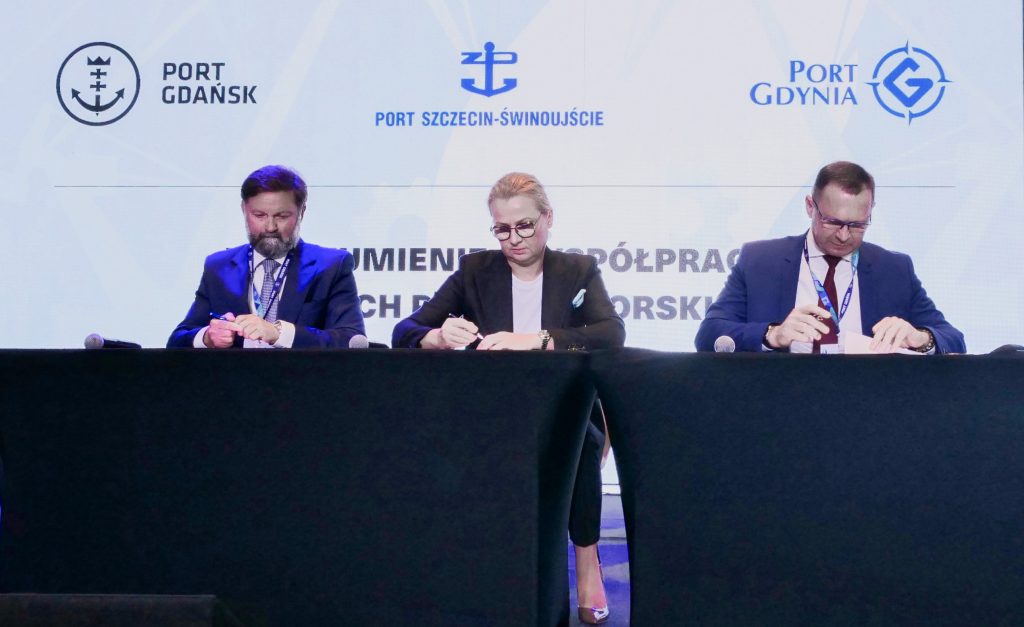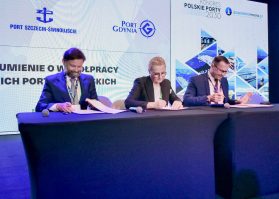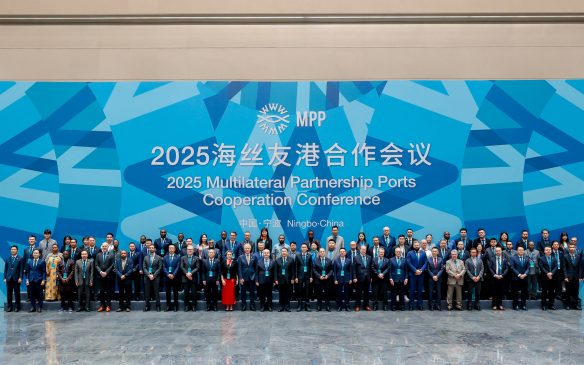Strategic agreement between seaports on partnership to promote competitiveness, security and resilience

Four Polish seaports of key importance to the national economy: Gdańsk, Gdynia, Szczecin and Świnoujście have concluded a Partnership Agreement aimed at strengthening their position in the European and global transport and logistics system. The agreement paves the way for joint action aimed at improving competitiveness, security and resilience, port infrastructure and technology. It also provides a solid foundation for strategic partnership in national and international activities shared by each of the ports.
‘The idea is to work together wisely’, said Arkadiusz Marchewka, Deputy Minister of Infrastructure, opening the Polish Ports 2030 Congress, during which the agreement was signed. ’It is not about not competing with each other: competition is good, it creates new opportunities, but stronger partnership will make Poland’s voice heard on the international stage. This is going to help us create a more attractive offer and reach new customers’.
Polish seaports continue to develop dynamically, which brings many challenges associated with operating in a globalised port and maritime economy. The partnership agreement signed on 24 June 2025 by the Management Boards of the Ports of Gdańsk, Gdynia, Szczecin and Świnoujście is an important step towards the completion of many ambitious strategic initiatives related to infrastructure, digitalisation and the energy transition of ports.
‘It is important that seaports in certain areas, such as those involved in sustainable port development and the blue economy, have joint points of view, which can translate into greater efficiency, implementation of standards and harmonisation of procedures, as well as adequate representation of the interests of Polish seaports in the European Union’, says Dorota Pyć, President of the Port of Gdańsk. ‘It is important to join forces, especially in times of geopolitical and economic turbulence.
The adopted port partnership strategy includes planning the sustainable development of ports and their logistics facilities, approaches to building interoperable IT systems, and implementing innovative technologies compliant with European Union guidelines.
‘Seaports are one of the most important links in the national economy. They generate multi-billion revenues for the state budget, attract investments, support exports and imports, and at the same time serve as critical infrastructure. Today’s challenges – from the energy transition, through geopolitical pressure, to regional competition – require not only operational efficiency, but also coordinated action at the strategic level. The agreement between three key ports is a step towards building a strong position for Poland in the European transport system. Strong ports mean a strong country – and this is not just an empty slogan, but a reality that can be measured and felt in the economy and security of the country’, emphasises Piotr Gorzeński, President of the Port of Gdynia.
An important element of the agreement is also the willingness to jointly represent the interests of ports before national and EU institutions, which is intended to strengthen their negotiating position and thus increase their chances of obtaining funds. Joint activities are also intended to contribute to greater practical use of the TEN-T network, crucial for transport and trade in the EU, by Polish ports.
‘Our common goal is to create ports of the future: modernised, digitised, environmentally sustainable and, at the same time, perfectly connected with national and European facilities’, declares Jarosław Siergiej, President of the Management Board of the Seaports of Szczecin and Świnoujście. ‘Particularly important for us is partnership in harmonising transport access and accelerating strategic investments, such as upgrading railway lines leading to ports and developing digital systems and port process automation’.
Prospects for decades
One of the main goals of the partnership is the joint development of a ‘Programme for the development of Polish seaports until 2035 with a perspective until 2060’.
At the same time, the parties declare their intention to work closely together to improve transport accessibility to seaports. Joint activities are going to focus on speeding up key infrastructure projects, like making a second connection to the Port Island in the Port of Gdańsk, building the Red Road in Gdynia, upgrading railway line 201, and revitalising the Nadodrzańska line. The development of connections with southern Europe and integration with the Rail Baltica network will also be important. Plans also include an analysis of the possibility to introduce a uniform methodology for charging for access to railway infrastructure in ports.
The agreement also places strong emphasis on energy transition. Ports are to become a space for the development of renewable energy projects, including systems for the production, processing and storage of renewable energy. Another key area will be the development of onshore power supply (OPS) infrastructure in line with EU requirements and the creation of a system for bunkering alternative fuels such as LNG, methanol, hydrogen and ammonia. Joint efforts will also focus on eliminating legislative barriers that hinder the development of such investments in ports.
AI and investments
Digitisation is another area of partnership aimed at improving the operational efficiency of ports through the Polish Port Community System (PCS) and joint IT solutions. The parties want to develop modern tools for managing maritime, road and rail traffic and handling goods. They declare the integration of national systems with EU solutions, including the European Maritime Single Window environment (EMSWe), which is a European system for the electronic reporting of information required when ships call at ports, and is intended to simplify formalities and reduce the need for paper documents.
In terms of investment conditions the signatories of the agreement plan to implement solutions that shall increase the attractiveness of port areas for investors. This includes changes to spatial development plans, adaptation of strategic documents and the introduction of long-term (at least 30-year) lease agreements as a tool to stimulate investment.
Measures in the formal and legal area are also important. One element of the agreement is the development of a system for monitoring and analysing customs clearance times as a tool to support further optimisation of processes in partnership with customs authorities and based on existing solutions. The development of digitisation and automation of customs procedures is to be based on existing PCS systems and the exchange of maritime security information. There are also plans to introduce tools using artificial intelligence to combat customs fraud and to identify and minimise unnecessary administrative burdens.
The signatories of the agreement jointly express their readiness to take consistent action to develop Polish seaports as modern, integrated logistics centres that meet the highest European standards. This is a milestone in building Poland’s strong position on the map of maritime transport and trade in Europe and other parts of the world.
The partnership is not only a symbolic step towards the integration of the national maritime sector, but also a clear signal to foreign partners that Poland wants to play an increasingly important role in the logistics of the Baltic Sea region, as well as Central and Eastern Europe.





